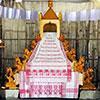The architectural structure begins with the enormous decorative gateway known as Batchora, laden with floral motifs, celestial beings, and hybrid animal sculptures. Inside the satra, the duar or door towards the main entrance is named mukhaduar, and the ones at the side are the Petduar. Some duars are seen with carved lion motifs called Simhaduar and others have floral motifs known as Phuljalikataduar. The institution of Namghars or prayer hall is the central structure of a Satra. It is the place where traditional hymns and kirtans are held. Inside the Namghar, we find various artistic motifs, beautifully carved doors and windows, substantial decorative posts supporting the prayer hall, hybrid animal sculptures, ancient manuscript paintings, and various artifacts.
The forms of art and the architectural representation acted as visual narratives of the Satra. Since architecture itself is a part of art, the unique architectural structures and details of the Satras captivated the mings, nobles, and devotees' minds. We can see numerous stylish features, unique motifs, highly decorative, precisely arranged compositions, particularized characters, varied ranges of color, secular and religious themes in the art and architectural forms.




